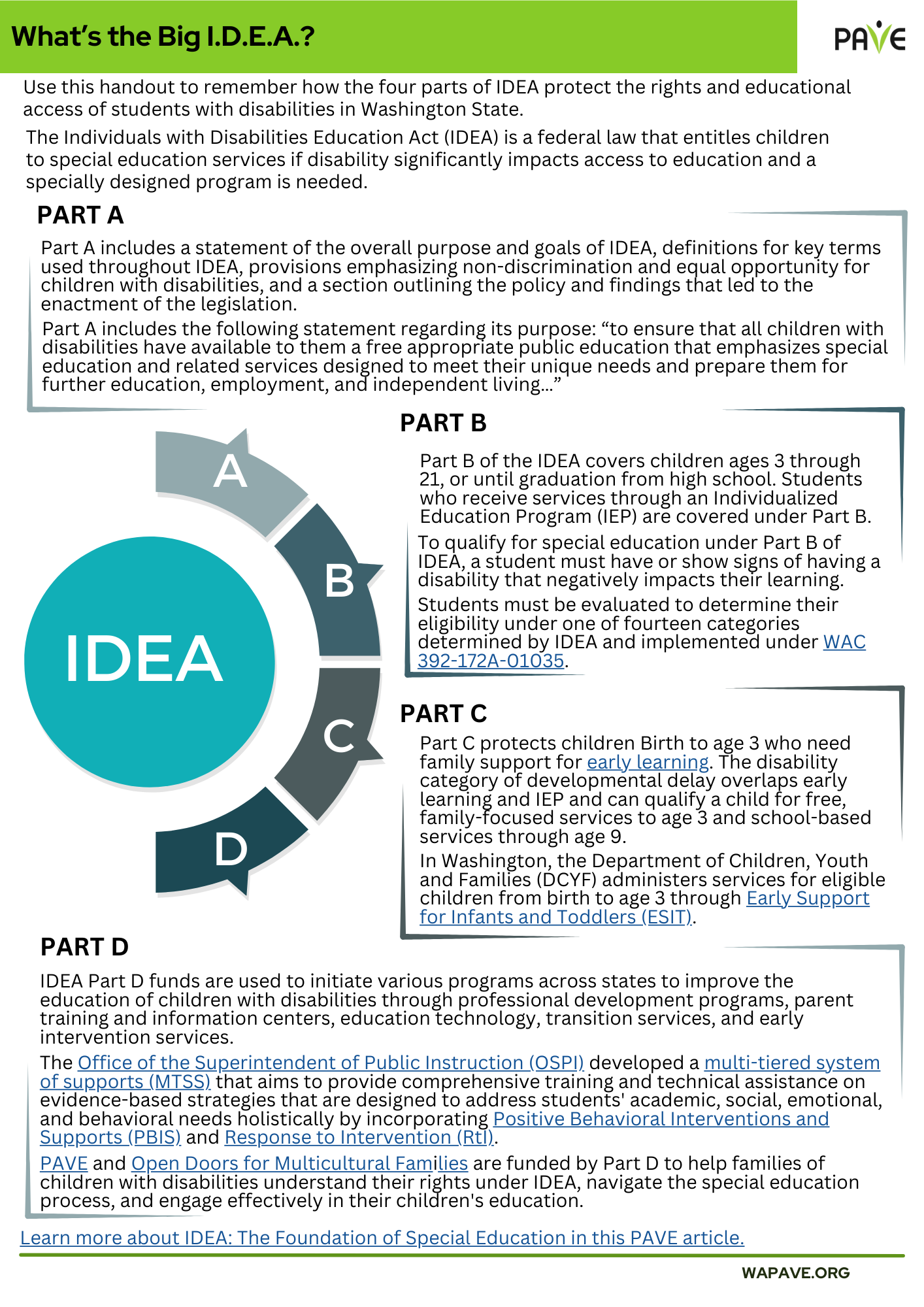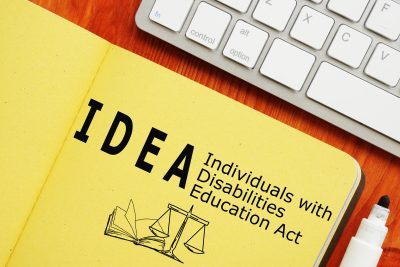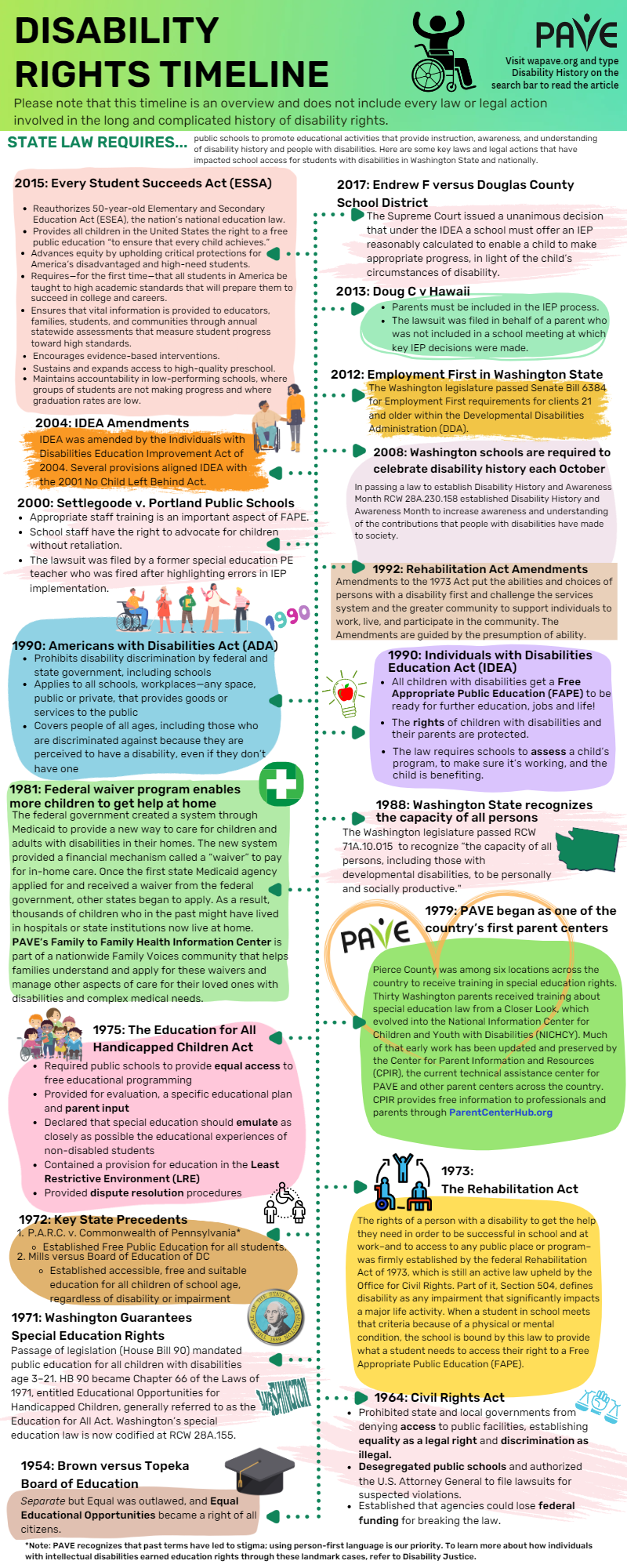A Brief Overview
- The Individuals with Disabilities Education Act (IDEA) is a federal law that entitles children to special education services if disability significantly impacts access to education and a specially designed program is needed.
- IDEA has been federal law since 1990, and key concepts are from the Education for All Handicapped Children Act, passed in 1975. PAVE provides an article and infographic about disability rights history.
- A primary principle of the IDEA is the right to FAPE (Free Appropriate Public Education) for students eligible for special education services. FAPE rights are also protected by civil rights laws, including Section 504 of the Rehabilitation Act of 1973.
- PAVE provides a three-part video training with further information: Student Rights, IEP, Section 504 and More.
Full Article
The Individuals with Disabilities Education Act (IDEA) is a federal law that was passed in 1990 and has been amended. The IDEA provides children with qualifying disabilities, from birth to age 21, with the right to services designed to meet their unique, individual needs.
Eligible children ages 3-21 who receive services at school have a right to FAPE: Free Appropriate Public Education. In accordance with the IDEA, FAPE is provided when individualized services enable a student with a disability to make progress that is appropriate, in light of their circumstances.
Services are delivered through an Individualized Education Program (IEP). A non-discriminatory evaluation and family participation on an IEP team are aspects of FAPE. Families have dispute resolution options that are described in the Procedural Safeguards.
IDEA requires FAPE to be provided in the Least Restrictive Environment to the maximum extent possible, which creates a responsibility for schools to serve students in the general education environment, with appropriately inclusive access to grade-level learning, whenever possible. Access to general education might be provided through an adapted curriculum, additional adult support, assistive technology, or something else. PAVE provides more information about Washington State’s work to improve inclusive practices.
Many of these concepts were part of IDEA’s predecessor law, the Education for All Handicapped Children Act, passed in 1975. That was the first United States law that required schools to provide special education services to all children with eligible disabilities. PAVE provides an article and infographic about disability rights history. The IDEA’s primary features are further detailed later in this article.
The IDEA drives how states design their own special education policies and procedures. Title 34, Part 104 is the non-discrimination federal statute under the Office for Civil Rights Department of Education. In Washington State, rules for the provision of special education are in Chapter 392-172A of the Washington Administrative Code (WAC).
FAPE is an important acronym to learn!
Families often ask: What does the school have to provide? The answer to that question is FAPE. The school district is responsible to make sure a student with an eligible disability condition is receiving FAPE.
As part of their right to FAPE, a student eligible for an IEP has the right to an individualized services program that ensures their education is appropriate, equitable, and accessible. All of those terms are part of FAPE. Figuring out how to provide FAPE is the work of an IEP team, and part of FAPE is ensuring that family is part of the decision-making team.
FAPE must ensure that the student finds meaningful success, in light of their circumstances. Trivial progress on IEP goals or the same goals year after year does not meet the federal standard for FAPE. A lawsuit referred to as Endrew F was settled by the 2017 U.S. Supreme Court and included specific requirements for meaningful progress and parent participation.
If a neighborhood school cannot provide the services and programming to guarantee FAPE within the general education classroom, then the school district is responsible to work through the IEP process to design an individualized program and placement that does meet the student’s needs. Keep in mind that Special Education is a Service, Not a Place: see PAVE’s article with that statement as its title.
IDEA considers the whole life of a person with a disability
IDEA includes Parts A, B and C. The right of a child with disabilities to receive an education that prepares that child for adult life is stated in Part A:
“Disability is a natural part of the human experience and in no way diminishes the right of individuals to participate in or contribute to society…
“Improving educational results for children with disabilities is an essential element of our national policy of ensuring equality of opportunity, full participation, independent living, and economic self-sufficiency for individuals with disabilities.”
Part B of the IDEA covers children ages 3 through 21—or until graduation from high school. Students who receive services through an Individualized Education Program (IEP) are covered under Part B.
Part C protects children Birth to age 3 who need family support for early learning. The disability category of developmental delay overlaps early learning and IEP and can qualify a child for free, family-focused services to age 3 and school-based services through age 9. PAVE provides an Early Learning Toolkit: Overview of Services for Families of Young Children.
To qualify for an IEP, a student meets criteria in one of the following eligibility categories. Washington State describes each eligibility category in WAC 392-172A-01035. For more information and resources related to each category, please refer to PAVE’s article, Evaluations Part 1: Where to Start When a Student Needs Special Help at School.
- Autism
- Emotional Behavioral Disability
- Specific Learning Disability
- Other Health Impairment
- Speech/Language Impairment
- Multiple Disabilities
- Intellectual Disability
- Orthopedic Impairment
- Hearing
- Deafness
- Deaf blindness
- Visual Impairment/Blindness
- Traumatic Brain Injury
- Developmental Delay (ages 0-9)

Click to print the explanation of IDEA
Educational evaluations ask 3 key questions:
The disability must have an adverse impact on learning. Not every student who has a disability and receives an evaluation will qualify for an IEP. Following procedures described by the IDEA, school districts evaluate students to consider 3 key questions:
- Does the student have a disability?
- Does the disability adversely impact education?
- Does the student need Specially Designed Instruction (SDI)?
When each answer is yes, a student qualifies for services. In each area of identified need, Specially Designed Instruction (SDI) is recommended to help the student overcome the impact of the disability to access FAPE. Progress in that area of learning is tracked through goal-setting and progress monitoring. PAVE provides various articles about the evaluation process, including a sample letter to refer a student for services.
IDEA’s Primary Principles
- Free Appropriate Public Education (FAPE): Students with disabilities who need a special kind of teaching or other help have the right to an education that is not only free but also appropriate, designed just for them. Under IDEA rules, schools provide special education students with “access to FAPE,” so that’s a common way to talk about whether the student’s program is working.
- Appropriate Evaluation: The IDEA requires schools to take a closer look at children with potential disabilities (Child Find Mandate). There are rules about how quickly those evaluations get done. The results provide information that the school and parents use to make decisions about how the child’s education can be improved.
- Individualized Education Program (IEP): An IEP is a dynamic program, not a packet of paper or a location (Special Education is a Service, Not a Place). The program is reviewed at least once a year by a team that includes school staff and family. Every student on an IEP gets some extra help from teachers, but the rest of the program depends on what a student needs to learn. Areas of need may be academic, social and emotional skills, and/or general life skills. By age 16, an IEP includes a plan for life beyond high school, and helping the student make a successful transition into life after high school becomes a primary goal of the IEP.
- Least Restrictive Environment (LRE): The IDEA says that students should be in class with non-disabled classmates “to the maximum extent appropriate.” Regular classrooms and school spaces are the least restrictive. If the school has provided extra help in the classroom but the special education student still struggles to access FAPE, then the IEP team considers other options. The school explains placement and LRE in writing on the IEP document. PAVE has an article about LRE.
- Parent and Student Participation: The IDEA and state regulations about IEP team membership make it clear that parents or legal guardians are equal partners with school staff in making decisions about their student’s education. When the student turns 18, educational decision-making is given to the student. The school does its best to bring parents and students into the meetings, and there are specific rules about how the school provides written records and meeting notices (WAC 392-172A-03100).
- Procedural Safeguards: The school provides parents with a written copy of their rights at referral and yearly thereafter. A copy of the procedural safeguards is downloadable in multiple languages from the Office of Superintendent of Public Instruction (OSPI), the guidance agency for Washington schools. Parents may receive procedural safeguards from the school any time they request them. They also may receive a copy if they file a complaint with the state. Procedural safeguards are offered when a school removes a student for more than 10 days in a school year through exclusionary discipline. When parents and schools disagree, these rights describe the actions a parent can take informally or formally.
PAVE provides information, training, resources, and 1:1 support through our Parent Training and Information (PTI) center. To get help, reach out through our Help Request Form or by calling 800-572-7368.


